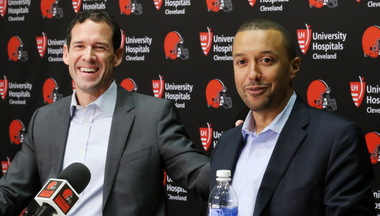Let’s break down the two trades that netted the Browns WR Corey Coleman and a slew of extra draft picks. This chart shows the hypothetical value of those picks according to two methods, the time-honored Jimmy Johnson draft value chart, and a more recent measure that values the historical perfomance of drafted players in the first four years of their careers above a replacement-level player. I consider the latter measure a more significant predictor of what level of performance to expect of draftees during their first contracts.
What neither valuation method accounts for is the diminished value of picks in future years. How much less is a pick worth if you have to sacrifice now to acquire it but can’t make use of it for a year or two? The only rule of thumb I’m familiar with is one round per year, so I’ve adjusted the values downward accordingly.
We also don’t know the exact overall position of the future picks. It depends on the success (or, we hope, the lack thereof) of the Eagles and Titans. For this purpose, the safest estimate seems to be the 16th pick of the respective round, right around the midpoint. (The Browns’ 2017 fourth-rounder included in the Eagles deal has been reported to be an expected compensatory pick near the end of the round.)
I would love to know what metric the Browns’ new braintrust used to value draft positions and how they accounted for the deferred acquisition costs of the future picks. It seems like their approach, like the PFP AV method, puts more weight on the potential of mid-round picks than a single player near the top of the draft.
It’s also forward-thinking, since they have no salary cap issues now, but spreading their higher picks over the next few years will make it easier to find room to retain more of the keepers into their late 20s, a key failure of the previous regime.
If you agree, you’ll see that the Browns came out smelling like roses in these two swaps.
Of course, it all comes down to which players are chosen and how they develop and contribute to their teams’ success. If Carson Wentz becomes a perennial Pro Bowler in Philly, the Browns will have again passed on a strapping, pocket-savvy franchise quarterback. But the Browns have many MANY more needs than that, especially given the decimating net losses in free agency over the past two years. So the stockpile approach to rebuilding has my support and my deepest hopes for a revitalized culture for this next generation of Browns football.
